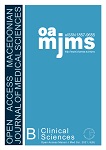Cell-free DNA in Human Follicular Fluid as Biomarker for Intracytoplasmic Sperm Injection Procedure Outcome
DOI:
https://doi.org/10.3889/oamjms.2021.7810Keywords:
Cell-free DNA, Human follicular fluid, Intracytoplasmic sperm injection, Procedure outcomeAbstract
Background: Follicular fluid considered as an important microenvironment for oocyte development, cell free-DNA (cfDNA) fragments that are found in this fluid and are released from cell apoptosis and/or necrosis, aimed to quantified the level of cf-DNA, in the follicular fluid and to assess any relation between the level of cf-DNA in this fluid with women’s age, duration of infertility, cause of infertility, her ovarian reserve values. Methods: Eighty-nine women were prospectively included in this study FF cf-DNA which was determined by conventional real time PCR-syber green detection approach which quantified by ALU-specific primers. Results: cell-free DNA (cfDNA) level in Follicular fluid samples of Iraqi women level was; cfDNA (Mean±SD, 0.916±0.106 ng/μl). there was no significant relation between cfDNA and pregnancy outcome, but very low level and very high level cf DNA were related to negative pregnancy outcome, cfDNA was second most important predictive factor of pregnancy outcome after fertilization rate, but both not statistically significant p value was (0.622 and 0.241) respectively. Conclusion: current study notice that cfDNA in the follicular fluid may mainly reflect the cellular activity and the balance between programed apoptosis and cell necrosis.
Downloads
Metrics
Plum Analytics Artifact Widget Block
References
Stiligliani S, Massarotti C, Scaruffi P. Pronuclear score improves prediction of embryo implantation success in ICSI cycles. BMC Pregnancy Childbirth. 2021;21(1):361. DOI: https://doi.org/10.1186/s12884-021-03820-7
Scalici E, Traver S, Molinari N, Mullet T. Cell-free DNA in human follicular fluid as a biomarker of embryo quality. Hum Reprod. 2014;29(12):2661. https://doi.org/10.1093/humrep/deu238 PMid:25267787 DOI: https://doi.org/10.1093/humrep/deu238
Uyar A, Torrealday S, Seli E. Cumulus and granulosa cell markers of oocyte and embryo quality. Fertil Steril. 2013;99(4):979-97. https://doi.org/10.1016/j.fertnstert.2013.01.129 PMid:23498999 DOI: https://doi.org/10.1016/j.fertnstert.2013.01.129
Assou S, Haouzi D, De Vos J, Hamamah S. Human cumulus cells as biomarker for embryo and pregnancy outcome. Mol Hum Reprod. 2010;16(8):531-8. https://doi.org/10.1093/molehr/gaq032 PMid:20435608 DOI: https://doi.org/10.1093/molehr/gaq032
Czamanski-Cohen J, Sarid O, Cwikel J. Increased plasma cell-free DNA is associated with low pregnancy rates among women undergoing IVF-embryo transfer. Reprod Biomed Online 2013;26:36-41. https://doi.org/10.1016/j.rbmo.2012.09.018 PMid:23182744 DOI: https://doi.org/10.1016/j.rbmo.2012.09.018
Baka S, Malamitisi A, Puchner. Novel follicular fluid factors influencing oocyte developmental potential in IVF: A review. Reprod Biomed. 2006;12(4):500-6. https://doi.org/10.1016/s1472-6483(10)62005-6 PMid:16740225 DOI: https://doi.org/10.1016/S1472-6483(10)62005-6
Daniel AD, David RM, Mandy GK. Oocyte environment: Follicular fluid and cumulus cells are critical for oocyte health, for oocyte health. Fertil Steril. 2015;103(2):303-16. https://doi.org/10.1016/j.fertnstert.2014.11.015 PMid:25497448 DOI: https://doi.org/10.1016/j.fertnstert.2014.11.015
Da Broi MG, Giorgi VS, Wang F, Keefe DL. Influence of follicular fluid and cumulus cells on oocyte quality: Clinical implications. J Assist Reprod Genet. 2018;35(5):735-51. https://doi.org/10.1007/s10815-018-1143-3 PMid:29497954 DOI: https://doi.org/10.1007/s10815-018-1143-3
Mandel P, Metais P. Nuclear acids in human blood plasma. C R Acad Sci Paris. 1948;142:241-3. PMid:18875018
Hui L, Maron JL, Gahan PB. Other body fluids as non-invasive source of cell-free DNA/RNA. Adv Predict Prev Pers Med 2015;5:295-323. DOI: https://doi.org/10.1007/978-94-017-9168-7_11
Pray IA. Discovery of DNA structure and function: Watsone and crick. Nat Educ. 2008;1(1):100.
Lo YM, Corbetta N, Chamberlain PF, Rai V, Sargent IT, Redman CW, Wainscoat JS. Presence of fetal DNA in maternal plasma and serum. Lancet. 1997;350:485-7. https://doi.org/10.1016/S0140-6736(97)02174-0 PMid:9274585 DOI: https://doi.org/10.1016/S0140-6736(97)02174-0
Liao JW, Gronowski AM. Non invasive prenatal testing using cell-free fetal DNA in maternal circulation. Clin Chim Acta. 2014;428:44-50. PMid:24482806 DOI: https://doi.org/10.1016/j.cca.2013.10.007
van Boeckel SR, Davidson DJ, Norman JE, Stock SJ. Cell-free DNA and spontaneous prterm birth. Reproduction. 2018;155(3):137-45. https://doi.org/10.1530/REP-17-0619 PMid:29269517 DOI: https://doi.org/10.1530/REP-17-0619
Amaral LM, Sandrium VC, Kutcher ME. Circulating total cell-free DNA levels are increased in hypertensive disorders of pregnancy and associated with prohypertensive factors and adverse clinical outcomes. Int J Mol Sci. 2021;22:564. https://doi.org/10.3390/ijms22020564 PMid:33429954 DOI: https://doi.org/10.3390/ijms22020564
Lee TJ, Rol DL. Menezes MA. Cell-free fetal DNA testing in singleton IVF conceptions. Hum Reprod. 2018;33(4):572-8. https://doi.org/10.1093/humrep/dey033 PMid:29462319 DOI: https://doi.org/10.1093/humrep/dey033
Pedini P, Graiet H, Laget L. Qualitative and quantitative comparison of cell-free DNA and cell-free fetal DNA isolation by four (semi-)automated extraction methods: Impact in two clinical applications: Chimerism quantification and noninvasive prenatal diagnosis. J Transl Med. 2021;19:15. DOI: https://doi.org/10.1186/s12967-020-02671-8
Jiang N, Reich CF 3rd, Pisetsky DS. Role of macrophages in the generation of circulating nucleosomes from dead and dying cells. Blood. 2003;102(6):2243-50. https://doi.org/10.1182/blood-2002-10-3312 PMid:12775567 DOI: https://doi.org/10.1182/blood-2002-10-3312
Grabusching S, Jacobous A, Holdenrieder S. Putative origins of cell-free DNA in humans: A review of active and passive nucleic acid release mechanisms. Int J Mol Sci. 2020;21(21):8062. https://doi.org/10.3390/ijms21218062 PMid:33137955 DOI: https://doi.org/10.3390/ijms21218062
Hengartner MO. The biochemistry of apoptosis. J Nat. 2000;407(6805):770-6. https://doi.org/10.1038/35037710 PMid:11048727 DOI: https://doi.org/10.1038/35037710
Naoyuki Umetani N, Kim J, Hiramatsu S, Reber HA, Hines OJ, Bilchik JA. Increased integrity of free circulating DNA in sera of patients with colorectal or periampullary cancer: Direct quantitative PCR for ALU repeats. Clin Chem. 2006;52:1062-9. https://doi.org/10.1373/clinchem.2006.068577 PMid:16723681 DOI: https://doi.org/10.1373/clinchem.2006.068577
Rodgers RJ, Iriving-Rodgers HF. Formation of ovarian follicular antrum and follicular fluid. Biol Reprod. 2010;82(6):1021-9. https://doi.org/10.1095/biolreprod.109.082941 PMid:20164441 DOI: https://doi.org/10.1095/biolreprod.109.082941
Czamanski-Cohen J, Sarid O, Cwikel J. Decrease in cell free DNA levels following participation in stress reduction techniques among women undergoing infertility treatment. Arch Womens Ment Health. 2014;17(3):251-3. https://doi.org/10.1007/s00737-013-0407-2 PMid:24420416 DOI: https://doi.org/10.1007/s00737-013-0407-2
Mendoza C, Ruiz-Requena E, Ortega E. Follicular fluid markers of oocyte developmental potential. Hum Reprod. 2002;17:1017-22. DOI: https://doi.org/10.1093/humrep/17.4.1017
Sabine T, Elodie S, Tiffany M. Cell-free DNA in human follicular microenvironment: New prognostic biomarker to predict in vitro fertilization outcomes. PLoS One J. 2015;10(8):1371. https://doi.org/10.1371/journal.pone.0136172 PMid:26288130 DOI: https://doi.org/10.1371/journal.pone.0136172
Downloads
Published
How to Cite
Issue
Section
Categories
License
Copyright (c) 2020 Maanee Azzam, Adeela Hamood, Hind Abdulkadim (Author)

This work is licensed under a Creative Commons Attribution-NonCommercial 4.0 International License.
http://creativecommons.org/licenses/by-nc/4.0








